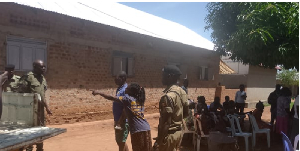General News of Wednesday, 15 December 1999
Source: Ghanaian Chronicle
Adansi Chiefs Cry Foul: Government Pockets 8.6b cedis Gold Cash
By Sebastian Freiku
Accra - The Chiefs of Adansi, the leading gold-producing district in Ghana, are angry with the ruling government over the non-payment of about 8.6billion cedis being 10% of royalties that have accrued to them for the past 15 months (October 1998 - present) even though the Ashanti Goldfields Company (AGC) has paid every bit of its obligation as at September, this year.
According to various official quarterly and annual reports, AGC had paid a total of $7million to the government as at September 1999.
AGC also paid $8.7 million and a further $8.6 million in 1997 and 1998 respectively, bringing the total payments to $24.3million.
Using an exchange rate of ?3500 to the dollar, the ten percent of the share of the chiefs should amount to about ?8.6billion.
The formula for the payment of the royalties, according to official sources, is 3% of the value of gold produced. The chiefs are also angry because the leadership of the ruling NDC government has snubbed their protest over delays in paying their royalties communicated to them in a petition in June this year.
This paper has seen series of correspondence between the government and Adansi chiefs which point to the fact that the two sides have been at war of late.
The chiefs were provoked by comments by the dismissed Minister of Mines and Energy, Mr. Fred Ohene Kena, to the effect that the Minerals Development Fund, into which all mineral royalties due government are paid is not royalties accruing to them (beneficiary stools and traditional authorities) as of right by virtue of their ownership of the minerals.
Ohene-Kena responding to a petition to the President said, the allocation of the royalties is at the discretion of the government who owns the minerals.
He emphasised in a letter dated September 20, 1999 that the application of mineral royalties is a prerogative of government.
"In the same way that the government decides to use the 80% for other developmental purposes not related to mining, it similarly decides to put the 20% into a fund to be disbursed to stools, Traditional Councils and District Assemblies in mining sector institutions."
Ohene Kena said the government decided to establish the Minerals Development Fund in 1993 to take care of the 20% of all mineral royalties accruing to it.
He explained that 10% of this goes into funding the Minerals Commission, Mines Department, Geological Survey and the Ministry of Mines and Energy.
The remaining 10%, Ohene Kena stated, is disbursed by the Administrator of Stool and Lands in accordance with Article 267(6) of the 1992 Constitution.
He gave the details of the proportion in which the 10% is disbursed: 25% to the stool for its maintenance while 20% is for the traditional authority with 55% to the District Assemblies.
In effect, District Assemblies receive 4.95% of the total royalty while the stools and the Traditional Authorities get 2.05% and 2% respectively.
The Adansi chiefs regard Ohene Kena's response as a mere comment and still demand a Presidential response to the petition of June 18.
The President and Divisional heads of the Traditional Council expressed concern over the irregular payment of the 10% due them and the attendant frustration.
According to the chiefs, the 10% due Adansi is not part of normal revenues coming under the appropriation law but a remittance from AGC and questioned why the government was holding on to it.
The chiefs argued that the payment of 10% to them after taking 80% with another 10% going to the Minerals Commission was not justified.
Referring to the Minerals Law of 1986 (PNDC Law 153) as amended by the minerals and Mining Act 481 of 1994 under the 1992 Constitution, the chiefs challenged the legal basis for the deduction of any part of the royalties to or by any institution other than the office of the Administrator of Stool lands and the use of part of the royalties for the establishment of Minerals Development Fund.
The government was also reminded of the 15% provision due them under the 1979 Constitution for its consideration.
Reacting to Ohene Kena's assertion that payment of royalties is at the discretion of the government and not by right, the Adansi chiefs questioned why payments of royalties particularly from AGC were made to only Adansi and Amansie on whose lands the minerals were mined and not to all traditional councils nationwide.
They asked "Are royalties from the Songhor Lagoon salt industry shared among all areas of Ghana?"
The chiefs maintained that the payments of part of the royalties to the Stools and traditional authorities is of right and not by the benevolence of government.
Now, the signatories of the petition, namely, the Adansihene, Nana Ofori Agyemang II, the Edubiasehene, Dompoasehene, Akrofuom hene, Akrokerrihene and the Krontihene of Bodwesango are even asking for an upward adjustment of the royalties to the chiefs and people of Adansi.
A second letter dated October 11 also asked for the early release of all royalties in order not to disrupt development programmes, especially scholarship schemes.
The chiefs have also asked for the direct payment of their share to the Administrator of Stool lands instead of the consolidated fund which they cited as the major cause of delays for the payment of royalties.
A press conference scheduled for November 11 this year by the aggrieved chiefs to address the issues was aborted at the eleventh hour to provide for a more positive and practical approach.










